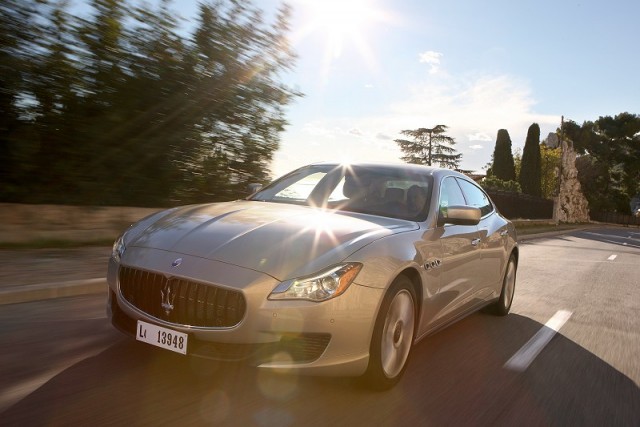Overall rating: 4/5
A tiny bit-part player in the global luxury market, Maserati is targeting a near ten-fold increase in sales over the next three years. Undoubtedly ambitious, but the more conventional, yet still highly desirable new Quattroporte spearheads the firm's new product offensive.
In the metal 4/5
Significantly bigger in its fifth generation, Maserati's Quattroporte takes up a good deal more road than its predecessor. Not as immediately pretty, the increase in size robs it of some of its beauty, but lined up alongside any of its luxury car rivals it's still the car you'll be drawn to for visual appeal. The front remains dominated by Maserati's vertically slatted grille framed by more technical looking lights and filled by a large Trident badge. There's more prominent detailing on its flanks, the smoothed off lines of the outgoing car replaced by more technical surfacing and a rear that's arguably a touch generic from a brand that's famous for its flair.
If the exterior is a bit of a surprise the interior is an absolute revelation. Gone is the haphazard switchgear and appalling infotainment, it replaced with a virtually button-free, nicely considered driving environment. There's a feeling of solidity and quality that was always absent on the old Quattroporte too, while the space on offer front and rear is in a completely different class. The Quattroporte feels like a car that's genuinely able to compete with the Mercedes-Benz S-Class, rather than positioned as an individualist's upstart on the luxury car fringe.
Driving it 4/5
This new car not only looks and feels significantly different inside and out, but it's an entirely different driving proposition over the previous Quattroporte. With its high-revving naturally aspirated engine and uncompromisingly sporting bias the old Quattroporte was always an uncomfortable fit in the same class as its supposed rivals. The new Quattroporte changes that. It's immediately a more mature drive, with a leaning towards comfort. Key to that is the engine, a 3.8-litre V8 with its twin turbochargers bringing torque to accompany the headline 530hp power figure. It'll still rev, but the need to wring the Quattroporte out at the very extremes of the engine's rev-band is no longer there. The turbochargers give significant torque from as low as 2,000rpm, bringing plenty of flexibility and an ease that was distinctly absent in the old car.
It's debatable that the change in character has brought with it a loss of driver appeal, as the once wild Quattroporte has undoubtedly been tamed. It is fast though, 100km/h arriving in just 4.7 seconds, the response and urgency in the mid-range in a completely different league to the old car. In its conventionality - as far as a 530hp car can be described as such - the Quattroporte is undeniably a new proposition for Maserati drivers.
There remains the option to tailor your drive via the Sport button, but press it and the ride becomes more brittle and the accelerator more digital, the Quattroporte an easier, more forgiving and smoother car when that Sport button is left alone. The steering offers fine feedback and weight and there's still the occasional overrunning cackling reminder from the exhausts that this is an Italian interpretation of a luxury car.
The once feisty, obviously rear-driven nature of the chassis is no more, the bigger, new Quattroporte feeling largely neutral with a bias towards gentle understeer when pushed hard. With 530hp driving the rear wheels it'll unquestionably play the hooligan if you desire, but its greater scale does mean you'll feel less likely to indulge yourself.
What you get for your money 4/5
You're paying for individuality, and that in the luxury car class is a good thing. It's still very much at the sporting end of the luxury market, simply because it's only offered with two petrol engines (European sales in this class are utterly dominated by diesel units). Specification levels haven't yet been confirmed, but expect a sizeable standard list including satnav, multi-zone climate control, adaptive headlamps and the likes if it's to compete with its intended rivals.
Worth Noting
The Quattroporte is the first step in Maserati's extremely ambitious growth plans in which the Italian firm expects to see sales rise from around 6,000 units to 50,000. Yes, really. Compounding that ambition is that Maserati hopes to achieve this by 2015. To do so it's planning a product blitz, which includes a sub-Quattroporte saloon named Ghibli and a new luxury SUV called Levante.
Summary
Many will lament the loss of the lunatic element of the old Maserati Quattroporte, but this new machine is exactly the car the firm needs if it's going to convince buyers out of other premium, sporting luxury saloons. It's still leftfield, admittedly, yet significantly more mainstream in its appeal. The Quattroporte is a genuine alternative in its class though ultimately its European sales success will always be hampered by the lack of a diesel engine in the line-up.




























































































































































